Driving in New Zealand
You need to meet a number of requirements to drive on New Zealand roads. Just like other drivers, you must have a current driver licence; but you may also need an international driving permit or translation if your licence isn’t in English.
You’ll need to consider more permanent arrangements if you’re in New Zealand for more than 12 months.
Permit or licence?
While most countries use the term 'driver licence', some countries use the term 'driver permit'. It's important not to confuse a 'driver permit' with an 'international driving permit'.
Can you drive in New Zealand?
You can drive in New Zealand if you hold a driver licence from another country or an international driving permit and:
- your overseas licence is current and valid, and
- you've not received a disqualification or suspension in New Zealand, and
- you last entered New Zealand less than 12 months ago, and
- your overseas licence is in English; if it's not, you must have an accurate translation, and
- you've not been granted a New Zealand driver licence.
If your licence or international driving permit doesn't meet these requirements, you must apply for a New Zealand driver licence to drive in New Zealand.
Here for a year or more?
If you'll be in New Zealand for more than a year, you need to gain a New Zealand driver licence. If your overseas licence is still current or expired less than 12 months ago you can apply to convert it to a New Zealand licence
How to convert your overseas driver licence to a New Zealand licence
- Apply at any driver licensing agent.
- Complete an Application for conversion of an overseas driver licence form (DL5) (either download this form, or get a copy from any driver licensing agent).
- Present your overseas driver licence (if your overseas licence is not in English you'll also need to present a translation of your overseas licence by an approved translator).
- Present evidence of your identity and your address.
- Present photocopies of all of the original evidence above.
- Present a current medical certificate, if required.
- Pass an eyesight screening check - unless you provide a current eyesight or medical certificate.
- Pay the licence fee. The amount will depend on the type of licence.
Depending on the country you come from, you may have to pass theory and practical tests.
New residents and visitors - driving in New Zealand
Published: 08 2011
This information is for new residents and visitors to New Zealand who only hold an overseas licence and provides information relating to your eligibility to drive in New Zealand, how to get a New Zealand driver licence, and other information relating to driving in New Zealand.
New residents and visitors – driving in New Zealand
The information in this page applies to licences for cars, motorcycles and heavy motor vehicles.
Can I drive in New Zealand?
Do you have a current and valid* overseas driver licence or international driving permit?
*A current and valid overseas driver licence means that your licence allows you to legally drive in your own country. If you are disqualified from driving or your licence is currently suspended, expired or revoked, then you are not allowed to drive in New Zealand.)
No – I don't have a current overseas driver licence or international driving permit
If you do not have a current and valid overseas driver licence, you cannot drive. You must apply for a New Zealand driver licence if you wish to drive here.
If your overseas driver licence has expired within the last 12 months, you may be able to convert it to a New Zealand licence. See factsheet 72 Overseas driver licence: converting to a New Zealand licence for more information.
Yes – I do have a current overseas driver licence or international driving permit
If you do have a current and valid overseas driver licence or international driving permit, you can drive using that for a maximum of 12 months from the date you arrived in New Zealand.
Note: If your overseas licence or permit isn't in English, you must carry an acceptable translation. See 'Other information you need to know' below for more information. Each time you visit New Zealand, you can drive for a further 12-month period on your overseas licence or international driving permit.
What happens after one year?
If you wish to continue driving after one year, you must obtain a New Zealand driver licence. We recommend you apply early to make sure you have a new licence before the one year is up. Forms to use to apply for an overseas licence conversion are available from NZ Transport Agency driver licensing agents. These are selected branches of:
Vehicle Inspection New Zealand (VINZ)
Vehicle Testing New Zealand (VTNZ).
Note: While an overseas driver licence may be converted to a New Zealand licence, an International Driving Permit cannot be converted to a New Zealand licence.
Questions and answers
What happens if I don't get a New Zealand driver licence?
If you have been in New Zealand for more than one year and have not obtained a New Zealand driver licence you'll be considered unlicensed and you must not drive. You could be charged by the police if you are caught driving (see the section 'Action police can take') and you may have any insurance claims declined.
Can I drive to earn money?
If you want to earn a living from driving you will probably have to convert your overseas licence to a New Zealand driver licence first, and you may also need to get a driver licence endorsement. You will certainly need to do so if you want to deal with the public or carry dangerous goods. For example, before you can earn money carrying passengers, driving a tow truck or working as a driving instructor or testing officer, you must complete courses, pass exams and be cleared by a police check in New Zealand.
You can call our our driver licensing contact centre on 0800 822 422 to find out more.
What happens if my licence is suspended or I am disqualified while driving in New Zealand?
If you're using an overseas driver licence or international driving permit to drive in New Zealand and are then suspended or disqualified from driving by a New Zealand court, you can no longer use your overseas driver licence or permit to drive in New Zealand. If you want to drive in New Zealand (after your disqualification or suspension has ended), you will need to get a New Zealand driver licence.
What else do I need to know?
Carry your licence when you're driving
In New Zealand, you must have your driver licence or international driving permit with you at all times when you're driving. (If you are using an international driving permit, you will need to carry both the permit and your overseas driver licence.) If your overseas driver licence or permit is not in English, you must carry an acceptable English translation issued by:
a translation service that has been authorised by the NZTA – a full list of acceptable translation services is available on our website, or
a diplomatic representative at a high commission, embassy or consulate, or
the authority that issued your overseas driver licence (an international driving permit may be acceptable as a translation).
Action police can take
You can find out about action the police can take in factsheet 55 Driving offences and their penalties.. Action the police may take includes the following:
Roadside licence suspension
Roadside licence suspension means the police immediately seize and suspend a driver's licence at the roadside. In addition to any other charges, the driver is banned from driving for 28 days. This can happen if you:
are caught driving at more than one-and-a-half times the legal alcohol limit
refuse to supply a blood sample to be tested for excess blood alcohol
are caught driving at more than 40km/h above a permanent speed limit (other than by speed cameras)
are caught for a drink drive offence and you have had a previous drink drive conviction in the last four years.
For more information on roadside licence suspension, see factsheet 62 Suspension of your licence at the roadside.
Roadside vehicle impoundment
Roadside vehicle impoundment means the police can seize and impound a vehicle for 28 days. A fee has to be paid before the vehicle is released. This can happen if you:
race other drivers or perform any other street-racer stunts (wheelies, unnecessary displays of speed, etc)
are caught for a drink drive offence where you have two or more previous drink drive convictions in the last four years
drive while disqualified
drive while your licence is suspended or revoked
are caught driving after having been forbidden to drive by police, and before obtaining a current licence (eg while you are unlicensed, or your licence has expired, or you are required to reinstate your licence after a licence suspension or disqualification).
For more information on roadside vehicle impoundment, see factsheet 63 Impoundment of your vehicle at the roadside.
If you've moved to New Zealand to live, read the New resident drivers brochure. This provides an overview of New Zealand driving rules and behaviours that you'll need to know about before you begin driving on our roads. It's available in English, Chinese, Japanese, Korean, Fijian, Samoan, Hindi and Malay. Phone our driver licensing contact centre on 0800 822 422 to order a copy, or visit the Publications section of our website.
If you're in New Zealand for a short stay, read the brochure What's different about driving in New Zealand? This gives you brief advice on aspects of driving in New Zealand that you may be unfamiliar with. It's written in English and has sections translated into German, Japanese, Korean and Chinese.
Phone our driver licensing contact centre on 0800 822 422 to order a copy, or visit the Publications section of our website.
Also available on our website:
factsheets on other aspects of driver licensing and road safety
information for motorists
The official New Zealand road code.
Drivers who are new to our roads, people learning to drive and people wanting to gain a new licence class must make use of the appropriate version of The official New Zealand road code. (There are different versions for cars, motorcycles and heavy vehicles.) The official New Zealand road code contains information you need to know to get a driver licence. It also has lots of information to help drivers be safe and courteous on the road.
Tips for driving in New Zealand
New Zealand road rules and driving behaviours may be different to those in your home country. For example:
- we drive on the left side of the road
- we have many hilly, narrow or windy roads that mean your journey make take longer than you expect.
- you must carry your driver licence on you at all times. If your licence is not in English, you must carry a translation from an approved translator.
What's different about driving in New Zealand?
Kia ora! Welcome to New Zealand.
.jpg)
There are a few things that you may not be used to when driving in New Zealand. For example:
- we drive on the left side of the road
- using a hand-held mobile phone while driving is illegal.
Make sure you have a safe and enjoyable journey – please take a few minutes to read this before starting out.
Keep left
.png)
Always drive on the left side of the road. If you drive on the right side of the road in your own country, please remember to keep left when pulling out onto the road - it's easy to forget where you are!
Giving way at intersections
In general, if you're turning, give way to all vehicles that are not turning.
Always use your indicator when turning.
No left turn on red
In New Zealand you may not turn left at an intersection when the traffic signals are red.
If turning at traffic signals, give way to pedestrians crossing the road.
Hand-held mobile phones
.jpg)
Drivers must not use a hand-held mobile phone when driving, unless the device is completely hands-free or mounted securely to the vehicle - and touched infrequently and briefly. Writing, reading or sending text messages on a mobile phone while driving is also illegal.
Travelling times
It's easy to underestimate travelling times in New Zealand.
Distances may seem short on paper, but New Zealand roads may be narrower than you're used to, cover hilly terrain and vary from motorways (freeways) to unsealed gravel roads.
If you're tired you're much more likely to have a crash. Here are some tips to help you stay alert.
- Get lots of rest before a long drive.
- Take a break from driving every two hours.
- If possible, share the driving with someone else.
- Avoid large meals and drink plenty of fluid.
- If you begin to feel sleepy, try to nap for up to 40 minutes.
- If you're feeling very tired - find a place to stay overnight.
Driving speeds
Speed limit signs show the maximum speed you can travel. However, at times you may need to drive at a slower speed due to road or weather conditions.
Different speed limits apply throughout New Zealand - look out for the speed limit signs.
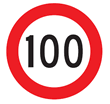
On most of New Zealand's main rural roads, the speed limit is 100km/h unless a sign says a lower speed applies. The speed limit is generally 100km/h on motorways.
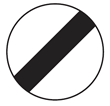
This sign indicates the default rural speed limit of 100km/h applies but the road is unlikely to be suitable to travel at that speed. You may need to drive at a slower speed.
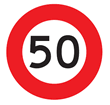
In urban areas, the speed limit is usually 50km/h unless a sign says otherwise.
Safety belts
.png)
By law, everyone in the vehicle must wear a safety belt - whether they're in the front or the back.
Children under five years of age must be secured in an approved child restraint.
Alcohol and Drugs
Don’t drink or use drugs and then drive – the laws against this are strictly enforced in New Zealand and penalties are severe.
Driver licence requirements
You must have your valid and current driver licence or international driving permit with you at all times when you're driving. If your overseas licence or permit is not in English, you must carry an accurate English translation issued by:
- an authorised translation provider in New Zealand
- a diplomatic representative at a high commission, embassy or consulate, or
- the authority that issued your overseas licence (an international driving permit may be acceptable as a translation).
If you hold a valid and current overseas driver licence or international driving permit, you can drive for a maximum of 12 months from the date you arrive in New Zealand.
Each time you visit New Zealand, you can drive for a further 12-month period on a valid overseas licence or international driving permit, as long as you stay for no more than a year at a time.
Overtaking
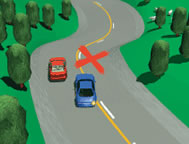
Most roads in New Zealand have a single lane each way, and some provide passing lanes at regular intervals - these should be used where possible when overtaking. You must not cross a solid yellow line on your side of the centre line to pass a vehicle, as this indicates it's too dangerous to overtake.
Sharing the road with cyclists
Cyclists have the same rights as drivers on New Zealand roads. Always slow down near cyclists, pass slowly and only when safe, and try to leave a space of 1.5 metres. Indicate in plenty of time and respect cycle lanes.
One lane bridges
A number of roads in New Zealand have one-lane bridges where vehicles travelling in one direction must give way to vehicles going in the other direction.
Any of the signs below show that you are approaching a one-lane bridge. Slow down and check for traffic coming the other way. The smaller red arrow shows which direction has to give way.
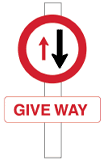

These two signs show you must give way to traffic coming the other way across the bridge.

This sign indicates that if no traffic is approaching, you can proceed across the bridge with caution.
Animals on the road

Watch out for farm animals on the road, particularly in rural areas. When you see them, slow down and do not sound your horn - it may startle them. You may need to stop and let the animals go past or move slowly up behind and follow the farmer's instructions.
Winter driving
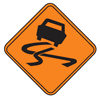
Look out for this slippery surface sign in wet or icy conditions - slow down and avoid braking suddenly.
Snow and ice can make roads even more hazardous, particularly around mountain passes. Rental vehicle companies will often supply chains if you're likely to be driving in these conditions - make sure you know how to fit them before setting out.
Unsealed (gravel) roads
.jpg)
Avoid unsealed roads if possible. If you need to drive on them, remember they can be very narrow. Reduce your speed to below 40–50km/h, and slow down even further when approaching oncoming traffic as dust could obscure your vision and loose stones could chip your windscreen.
Parallel parking
In New Zealand, you can be fined or towed away for parallel parking on the wrong side of the road. You may only park in the direction of traffic flow on your side of the road (ie on the left side) unless it is a one-way street.
Rail crossings

Only half of New Zealand’s 1500 public rail crossing are protected by automatic alarms. For example, if red lights are flashing, stop and only proceed once the lights have stopped flashing.
Other crossings are protected by Railway Crossing and Give Way or Stop signs only. When you see a Stop sign at a crossing, stop and only cross the track if there are no trains approaching. When you see a Give Way sign, slow down and be ready to stop and only cross the track if there are no trains approaching.

|
| Make a Booking |
| Our feedbacks or testimonials |
| For Fast response Ph / TXT : 027 287 9893 |
|
Type of Licence |
Pass Rate |
|---|---|
| Full standard | 100% |
| Overseas conversion | 100% |
| Restricted license | 98% |
| Heavy vehicle | 100% |
| Motorbike | 100% |
I Want To.... |
| ....Do Driving lesson |
| ....Do Driving Assessments. |


.jpg)
